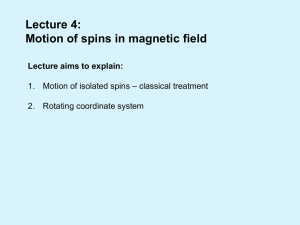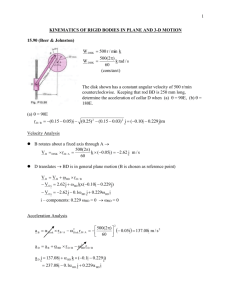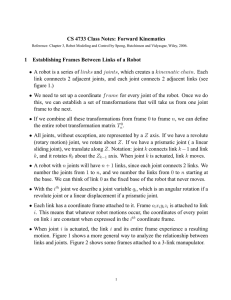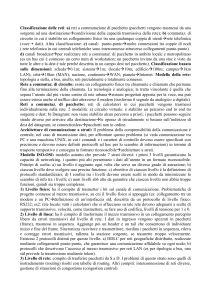Lecture #4 16.61 Aerospace Dynamics • 1
advertisement
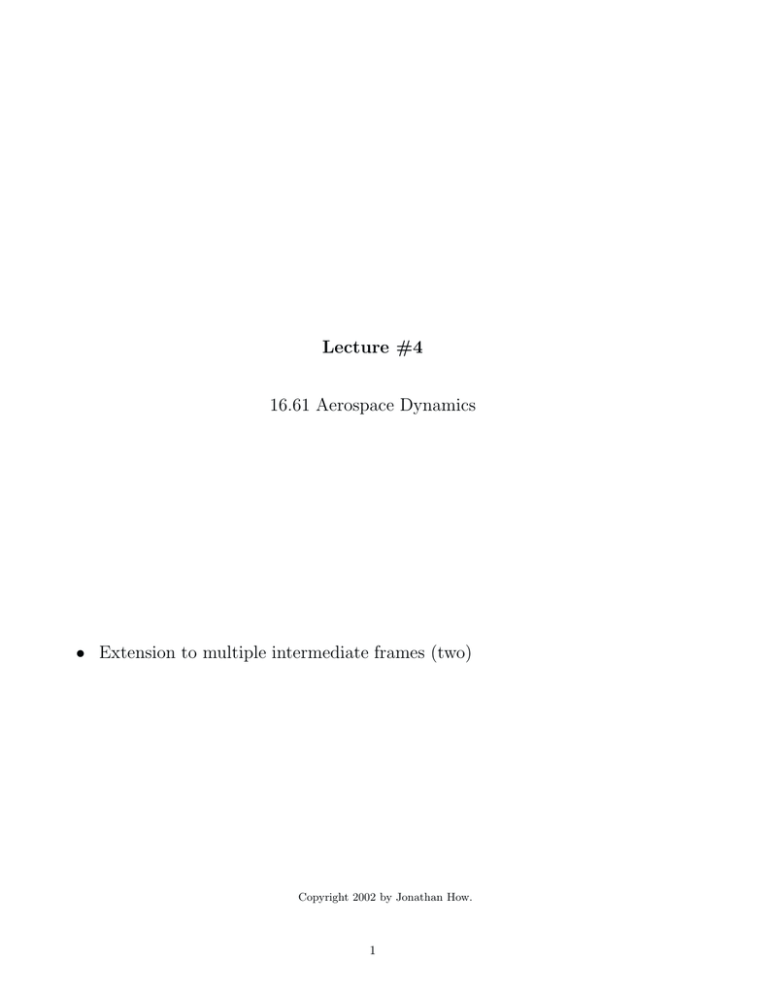
Lecture #4 16.61 Aerospace Dynamics • Extension to multiple intermediate frames (two) Copyright 2002 by Jonathan How. 1 Spring 2003 16.61 4–1 Introduction • We started with one frame (B) rotating ω and accelerating ω˙ with respect to another (I), and obtained the following expression for the absolute acceleration I I r¨ = r¨cm + ρ¨ B + 2ω × ρ˙ B I + ω˙ × ρ + ω × (ω × ρ) of a point located at r = rcm + ρ • However, in many cases there are often several intermediate frames that have to be taken into account. • Consider the situation in the figure: – Two frames that are moving, rotating, accelerating with respect to each other and the inertial reference frame. – Assume that 2ω and 2ω˙ 1 are given with respect to the first intermediate frame 1. ✸ The left superscript here simply denotes a label – there are two ω ’s to consider in this problem. • Note that the position of point P with respect to the origin of frame 1 is given by P1 r = 2r + 3r and the position of point P with respect to the origin of the inertial frame is given by PI • We want PI ˙ I r and r = 1r + 2r + 3r ≡ 1r + P 1r PI¨ I r Spring 2003 16.61 4–2 • The approach is to find the motion of P with respect to frame 1. P1 ˙ 1 r 1 1 = 2r˙ + 3r˙ ≡ P 1v 1 2 = 2r˙ + ( 3r˙ + 2ω × 3r ) and P 1¨ 1 r = = 2¨ 1 1 r + 3r¨ ≡ P 1a 2 2 2¨ 1 r + ( 3¨r + 2( 2ω × 3r˙ ) + 2ω˙ 1 × 3r + 2ω × ( 2ω × 3r )) • While the notation is a bit laborious, there is nothing new here – this is just the same case we have looked at before with one frame moving with respect to another. – Steps above were done ignoring the motion of frame 1 altogether. • Now consider what happens when we include the fact that frame 1 is moving with respect to the inertial frame I. Again: PI r = 1r + 2r + 3r ≡ 1r + P 1r Now compute the desired velocity: PI ˙ I r I I = 1r˙ + P 1r˙ ≡ P I v I 1 × P 1r ) = 1r˙ + P 1r˙ + ( 1ω 1˙ I 2˙ 1 3˙ 2 = r + r + ( r + ω × r ) + 1ω × ( 2r + 3r ) 2 3 I 1 2 + 2ω ) × 3r = 1r˙ + 2r˙ + 3r˙ + 1ω × 2r + ( 1ω Spring 2003 16.61 4–3 And acceleration: PI¨ I r I I = 1r¨ + P 1r¨ ≡ P Ia dI P 1 ˙ I 1¨ I = r + r dt dI P 1 ˙ 1 1¨ I 1 P1 = r + r + ( ω × r ) dt I 1¨ I P 1¨ 1 1 P1 ˙ 1 r + ω × r + 1ω˙ × P 1r = r + + ω × 1 P1 ˙ 1 r + ω × 1 P1 r • Now substitute and condense. PI¨ I r I 1 1 I = 1¨r + P 1¨r + 2( 1ω × P 1r˙ ) + 1ω˙ × P 1r + 1ω × ( 1ω × P 1r ) I = 1¨r + 2¨ 1 3¨ 2 2 3˙ 2 2˙ 1 3 2 2 3 r + ( r + 2( ω × r ) + ω × r + ω × ( ω × r )) +2 1 ω × I + ω˙ × 1 2˙ 1 3˙ 2 r + r + ω × r 2 3 r + r + ω × ( ω × 2 3 1 1 2 3 r + r ) I 1 2 2 1 = 1¨r + 2r¨ + 3¨r + 2([ 1ω + 2ω ] × 3r˙ ) + 2( 1ω × 2r˙ ) I I 1 + 1ω˙ × 2r + [ 1ω˙ + 2ω˙ ] × 3r + 2ω × ( 2ω × 3r ) + 1ω × ( 1ω × [ 2r + 3r ]) + 2 1ω × ( 2ω × 3r ) Spring 2003 16.61 4–4 • This final expression looks messy, but it is really just two nested versions of what we have seen before. – The nesting can continue to more levels and can be automated. • Note that this type of expression is very easy to get wrong if not done carefully and systematically. – The hardest term to capture here is the 2 1ω × ( 2ω × 3r ) which 1 comes from the 2( 1ω × P 1r˙ ) term. – P1 ˙ 1 r is the relative velocity of P with respect to the origin of frame 1 as seen by an observer in the rotating frame 1. • Example: acceleration of the tip of the tail rotor on a helicopter: – The helicopter body is rotating. – The tail rotor is rotating as well, but the base is attached to the body.
